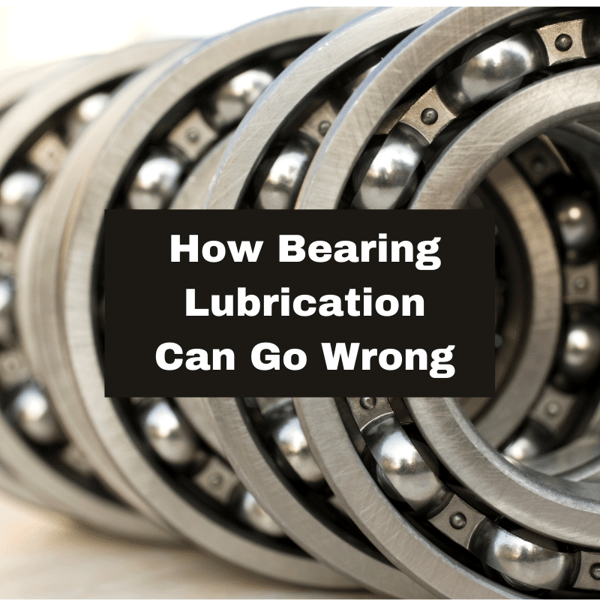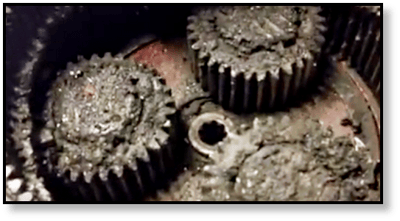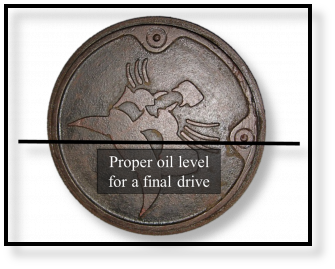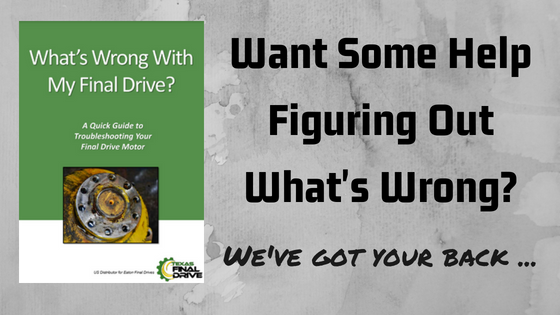Most of the time, when we think of issues with final drive bearings, we think about having too little gear oil or maybe not changing it often enough. You might be surprised by some of the other ways that lubrication can cause some serious problems for your final drive bearings--especially those in the planetary hub.

Here are a few other blog posts you might find useful:
- Final Drive Maintenace: Gear Oil
- How to Troubleshoot Gear Oil Problems
- How to Troubleshoot an Overheating Gearbox
Mixing Different Gear Oils
Some lubricants just can't be mixed with others, and different grades should never be mixed together--and grease and gear oil should never be mixed, either. For example, when different types of lubricants are mixed together, they may contain chemicals that are not compatible. Mixing polyglycol synthetic gear oils (PAG or PG) with other lubricant types can cause a gummy gel to form.
Other problematic chemicals within different gear oils may be additives or thickening agents. As Machinery Lubrication explains, additive packages are highly specific to the machines they are intended for. This is why hydraulic fluid (which has anti-wear additives) should not be substituted for gear oil (which has extreme pressure additives).
In another article, Machinery Lubrication points out that when different viscosities (thickness) are combined, the resulting viscosity is going to be extremely unpredictable. If it ends up being too thick, your drive motor may overheat. If it ends up too thin, the result may be metal-to-metal contact that accelerates wear and can also lead to overheating.
Wrong Type of Gear Oil
If you use the wrong type of gear oil, there are several things that can go wrong. Let's consider viscosity first, going into more detail than we did in the previous section. If the viscosity is too high,
- It may not be able to flow where needed, resulting in metal-to-metal contact and accelerated wear
- Components may be forced to churn through it, leading to energy losses
- It will be difficult to conduct heat away, which raises drive motor temperature, increases friction, and leads to energy losses
- In cold weather it may not be able to provide sufficient protection, causing metal-to-metal contact, accelerated wear, friction, and energy losses
If the viscosity is too low, it may not be able to provide protection between components, leading to metal-to-metal contact, accelerated wear, increased friction, energy losses, and an overheating final drive--and a risk of bearing damage and wear. And here's something else to consider: an overheating final drive leads to burned gear oil, and we can recognize the smell the moment we open a final drive up.

Burned gear oil is a serious problem.
We recommend 80/90W gear oil for your final drive motors. It's a good multipurpose gear oil that is commonly used by construction equipment. As we discussed earlier, it is an EP (extreme pressure) lubricant and may include additives such as friction modifiers, anti-corrosion, anti-rust, anti-wear, and anti-oxidation. It is available as a mineral-based oil or synthetic oil.
Contaminated Gear Oil
If you've been following the Shop Talk Blog for very long, you know we are very passionate about contamination because of the damage it can lead to. And that includes not just hydraulic contamination but contaminated gear oil as well.
One of the main sources of contamination for gear oil involves a leaking oil seal. If gear oil can leak out through a failing seal, then dust, sand, dirt, water, and other things can eventually make their way in. Contamination can also be generated internally as the planetary gears, bearings, and axles start to wear. Bits and flakes of metal can break off, and that's going to lead to some serious issues.

This was the result of a leaking seal ignored so long that all the gear oil was replaced with dirt and mud and the bearings are packed with it.
When you check or change the gear oil, note that the plugs are usually magnetized to make it easy to spot metallic contamination. If you see flecks of metal that look like glitter, then you have a part (most likely a bearing) that's rapidly wearing in your final drive and is putting your bearings at risk.
Too Little Gear Oil
Like contaminated gear oil, too little gear oil is a major issue. It leads to surface-to-surface without the lubricant to protect the surfaces. This is particularly serious for antifriction bearings (ball, roller, and needle bearings) and plane bearings.
According to gear manufacturer Timken, there are four progressive levels of damage:
- Discoloration that results from heat generation due to friction causes the lubricant to stain the surface of bearings (or in severe cases, discolor the metal itself)
- Peeling and scoring due to surface-to-surface contact under high loads without lubrication
- Localized scoring resulting from a combination of direct surface-to-surface contact.,high temperatures, breakdown of the lubricating film
- Total bearing lockup where cumulative wear and localized heat change the geometry of the bearing or the internal clearance, leading to the destruction of the cage, skewed rollers, serious metal transfer, loss of power, and even bearing seizure
This is why we encourage our customers to check their gear oil levels once every 100 hours of operation.

Aging Gear Oil
Gear oil doesn't have an unlimited life -- aging is inevitable. Over time, the chemicals within the gear oil will start to break down. This reduces its performance and will eventually cause damage to your final drive. If your gear oil has a horrific smell and looks like thick sludge, it's doing more damage than good for your bearings. And your gear oil will also age faster if your final drive is running hot. We recommend you change out the gear oil at least once a year.
Conclusion
Your bearings are a critical part of your final drive motor, both on the hydraulic and planetary sides. Paying attention to the gear oil levels and conditions and using the right kind of gear oil will go far in ensuring your bearings last.


